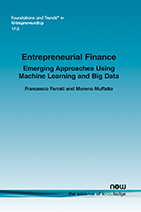Entrepreneurial Finance: Emerging Approaches Using Machine Learning and Big Data
By Francesco Ferrati, School of Entrepreneurship (SCENT), Department of Industrial Engineering, University of Padova, Italy, francesco.ferrati@unipd.it | Moreno Muffatto, School of Entrepreneurship (SCENT), Department of Industrial Engineering, University of Padova, Italy, moreno.muffatto@unipd.it
Abstract
For equity investors the identification of ventures that most likely will achieve the expected return on investment is an extremely complex task. To select early-stage companies, venture capitalists and business angels traditionally rely on a mix of assessment criteria and their own experience. However, given the high level of risk with new, innovative companies, the number of financially successful startups within an investment portfolio is generally very low. In this context of uncertainty, a data-driven approach to investment decision-making can provide more effective results. Specifically, the application of machine learning techniques can provide equity investors and scholars in entrepreneurial finance with new insights on patterns common to successful startups.
This study presents a comprehensive overview of the applications of machine learning algorithms to the Crunchbase database. We highlight the main research goals that can be addressed and then we review all the variables and algorithms used for each goal. For each machine learning algorithm, we analyze the respective performance metrics to identify a baseline model. This study aims to be a reference for researchers and practitioners on the use of machine learning as an effective tool to support decision-making processes in equity investments.
Entrepreneurial Finance: Emerging Approaches Using Machine Learning and Big Data
Entrepreneurial Finance: Emerging Approaches Using Machine Learning and Big Data presents a comprehensive overview of the applications of machine learning algorithms to the Crunchbase database. The authors highlight the main research goals that can be addressed and review all the variables and algorithms used for each goal. For each machine learning algorithm, the authors analyze the respective performance metrics to identify a baseline model. This study aims to be a reference for researchers and practitioners on the use of machine learning as an effective tool to support decision-making processes in equity investments.
Section 2 provides an introduction to machine learning and outlines the main differences from a traditional statistical approach. Section 3 provides an overview of the venture capital firms that have already applied a data-driven approach to their investment decision-making. Section 4 is an introduction to Crunchbase, one of the most relevant databases on startup companies and investors. Section 5 describes the scope of this study, focusing on research contributions that have applied machine learning techniques to Crunchbase data. Section 6 classifies the studies’ research goals and describes the various machine learning approaches. Section 7 describes an example of how the models proposed by previous studies could be integrated synergistically into investor decision-making. Section 8 synthesizes all the features or variables used, which are obtained either directly from Crunchbase or through a features engineering process. Section 9 analyses the algorithms used. Section 10 discusses the results obtained in previous research in order to establish a baseline for future research in this field. Finally, section 11 presents a final discussion of the applicability of machine learning as a tool for data-driven investments, while conclusions and future developments are presented in section 12.
